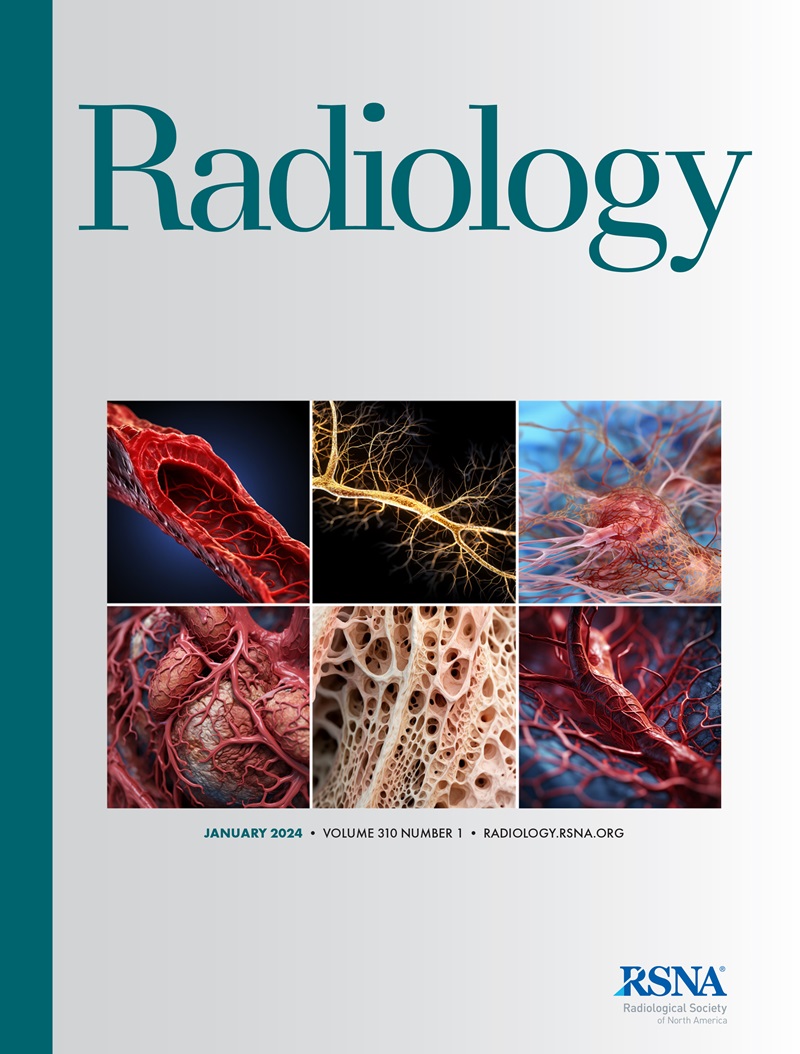Comparison of Multiparametric MRI-targeted and Systematic Biopsies for Detection of Cribriform and Intraductal Carcinoma Prostate Cancer.
Sangeet Ghai, Laurence Klotz, Gregory R Pond, Marlene Kebabdjian, Michelle R Downes, Eric C Belanger, Madeleine Moussa, Theodorus H van der Kwast
求助PDF
{"title":"Comparison of Multiparametric MRI-targeted and Systematic Biopsies for Detection of Cribriform and Intraductal Carcinoma Prostate Cancer.","authors":"Sangeet Ghai, Laurence Klotz, Gregory R Pond, Marlene Kebabdjian, Michelle R Downes, Eric C Belanger, Madeleine Moussa, Theodorus H van der Kwast","doi":"10.1148/radiol.231948","DOIUrl":null,"url":null,"abstract":"<p><p>Background Intraductal carcinoma (IDC) and invasive cribriform (Cr) subtypes of prostate cancer (PCa) are an indication of aggressiveness, but the evidence regarding whether MRI can be used to detect Cr/IDC-pattern PCa is contradictory. Purpose To compare the detection of Cr/IDC-pattern PCa at multiparametric MRI (mpMRI)-targeted biopsy versus systematic biopsy in biopsy-naive men at risk for PCa. Materials and Methods This study was a secondary analysis of a prospective randomized controlled trial that recruited participants with a clinical suspicion of PCa between April 2017 and November 2019 at five centers. Participants were randomized 1:1 to either the MRI arm or the systematic biopsy arm. Targeted biopsy was performed in participants with a Prostate Imaging Reporting and Data System score of at least 3. MRI features were recorded, and biopsy slides and prostatectomy specimens were reviewed for the presence or absence of Cr/IDC histologic patterns. Comparison of Cr/IDC patterns was performed using generalized linear mixed modeling. Results A total of 453 participants were enrolled, with 226 in the systematic biopsy arm (median age, 65 years [IQR, 59-70 years]; 196 biopsies available for assessment) and 227 in the mpMRI-targeted biopsy arm (median age, 67 years [IQR, 60-72 years]; 132 biopsies available for assessment). Identification of Cr/IDC PCa was lower in the systematic biopsy arm compared with the mpMRI arm (31 of 196 biopsies [16%] vs 33 of 132 biopsies [25%]; <i>P</i> = .01). No evidence of a difference in mean cancer core length (CCL) (11.3 mm ± 4.4 vs 9.7 mm ± 4.5; <i>P</i> = .09), apparent diffusion coefficient (685 µm<sup>2</sup>/sec ± 178 vs 746 µm<sup>2</sup>/sec ± 245; <i>P</i> = .52), or dynamic contrast-enhanced positivity (27 [82%] vs 37 [90%]; <i>P</i> = .33) for clinically significant PCa (csPCa) was observed between participants with or without Cr/IDC disease in the MRI arm. Cr/IDC-positive histologic patterns overall had a higher mean CCL compared with Cr/IDC-negative csPCa (11.1 mm ± 4.4 vs 9.2 mm ± 4.1; <i>P</i> = .009). Conclusion MRI-targeted biopsy showed increased detection of Cr/IDC histologic patterns compared with systematic biopsy. Clinical trial registration no. NCT02936258 © RSNA, 2024 <i>Supplemental material is available for this article.</i> See also the editorial by Scialpi and Martorana in this issue.</p>","PeriodicalId":20896,"journal":{"name":"Radiology","volume":null,"pages":null},"PeriodicalIF":12.1000,"publicationDate":"2024-07-01","publicationTypes":"Journal Article","fieldsOfStudy":null,"isOpenAccess":false,"openAccessPdf":"","citationCount":"0","resultStr":null,"platform":"Semanticscholar","paperid":null,"PeriodicalName":"Radiology","FirstCategoryId":"3","ListUrlMain":"https://doi.org/10.1148/radiol.231948","RegionNum":1,"RegionCategory":"医学","ArticlePicture":[],"TitleCN":null,"AbstractTextCN":null,"PMCID":null,"EPubDate":"","PubModel":"","JCR":"Q1","JCRName":"RADIOLOGY, NUCLEAR MEDICINE & MEDICAL IMAGING","Score":null,"Total":0}
引用次数: 0
引用
批量引用
Abstract
Background Intraductal carcinoma (IDC) and invasive cribriform (Cr) subtypes of prostate cancer (PCa) are an indication of aggressiveness, but the evidence regarding whether MRI can be used to detect Cr/IDC-pattern PCa is contradictory. Purpose To compare the detection of Cr/IDC-pattern PCa at multiparametric MRI (mpMRI)-targeted biopsy versus systematic biopsy in biopsy-naive men at risk for PCa. Materials and Methods This study was a secondary analysis of a prospective randomized controlled trial that recruited participants with a clinical suspicion of PCa between April 2017 and November 2019 at five centers. Participants were randomized 1:1 to either the MRI arm or the systematic biopsy arm. Targeted biopsy was performed in participants with a Prostate Imaging Reporting and Data System score of at least 3. MRI features were recorded, and biopsy slides and prostatectomy specimens were reviewed for the presence or absence of Cr/IDC histologic patterns. Comparison of Cr/IDC patterns was performed using generalized linear mixed modeling. Results A total of 453 participants were enrolled, with 226 in the systematic biopsy arm (median age, 65 years [IQR, 59-70 years]; 196 biopsies available for assessment) and 227 in the mpMRI-targeted biopsy arm (median age, 67 years [IQR, 60-72 years]; 132 biopsies available for assessment). Identification of Cr/IDC PCa was lower in the systematic biopsy arm compared with the mpMRI arm (31 of 196 biopsies [16%] vs 33 of 132 biopsies [25%]; P = .01). No evidence of a difference in mean cancer core length (CCL) (11.3 mm ± 4.4 vs 9.7 mm ± 4.5; P = .09), apparent diffusion coefficient (685 µm2 /sec ± 178 vs 746 µm2 /sec ± 245; P = .52), or dynamic contrast-enhanced positivity (27 [82%] vs 37 [90%]; P = .33) for clinically significant PCa (csPCa) was observed between participants with or without Cr/IDC disease in the MRI arm. Cr/IDC-positive histologic patterns overall had a higher mean CCL compared with Cr/IDC-negative csPCa (11.1 mm ± 4.4 vs 9.2 mm ± 4.1; P = .009). Conclusion MRI-targeted biopsy showed increased detection of Cr/IDC histologic patterns compared with systematic biopsy. Clinical trial registration no. NCT02936258 © RSNA, 2024 Supplemental material is available for this article. See also the editorial by Scialpi and Martorana in this issue.
多参数磁共振成像靶向活检与系统性活检在检测前列腺癌楔形细胞和导管内癌方面的比较
背景 前列腺癌(PCa)的导管内癌(IDC)和浸润性楔形细胞癌(Cr)亚型是侵袭性的一种表现,但有关磁共振成像是否可用于检测Cr/IDC型PCa的证据却相互矛盾。目的 比较多参数磁共振成像(mpMRI)靶向活检与系统性活检对PCa高危男性中Cr/IDC型PCa的检测效果。材料与方法 本研究是一项前瞻性随机对照试验的二次分析,该试验于2017年4月至2019年11月期间在五个中心招募了临床怀疑患有PCa的参与者。参与者按 1:1 随机分配到核磁共振成像组或系统活检组。对前列腺影像报告和数据系统评分至少为3分的参与者进行了靶向活检。记录了MRI特征,并对活检切片和前列腺切除术标本进行了审查,以确定是否存在Cr/IDC组织学模式。采用广义线性混合模型对Cr/IDC模式进行比较。结果 共有453名参与者参加,其中系统活检组226人(中位年龄65岁[IQR, 59-70岁];196份活检样本可供评估),mpMRI靶向活检组227人(中位年龄67岁[IQR, 60-72岁];132份活检样本可供评估)。系统活检组与 mpMRI 组相比,Cr/IDC PCa 的识别率较低(196 例活检中的 31 例 [16%] 与 132 例活检中的 33 例 [25%];P = .01)。在 MRI 组有或没有 Cr/IDC 病变的参与者之间,没有证据表明平均癌芯长度 (CCL) (11.3 mm ± 4.4 vs 9.7 mm ± 4.5; P = .09)、表观弥散系数 (685 µm2/sec ± 178 vs 746 µm2/sec ± 245; P = .52) 或动态对比增强阳性率 (27 [82%] vs 37 [90%]; P = .33) 有临床意义的 PCa (csPCa) 存在差异。与Cr/IDC阴性的csPCa相比,Cr/IDC阳性组织学形态的CCL平均值更高(11.1 mm ± 4.4 vs 9.2 mm ± 4.1;P = .009)。结论 与系统性活检相比,MRI靶向活检可提高Cr/IDC组织学模式的检出率。临床试验注册号NCT02936258 © RSNA, 2024 本文有补充材料。另请参阅 Scialpi 和 Martorana 在本期发表的社论。
本文章由计算机程序翻译,如有差异,请以英文原文为准。


